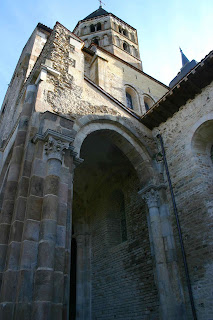I've posted before about medieval monasticism. Today I want to discuss one particular monastery and its associated monastic order, that of Cluny.
Cluny was founded in Burgundy in 910 by the powerful duke of Aquitaine, who specifically said that neither he nor any other layman would meddle in the monastery’s affairs. This was a big concession at a time, in the aftermath of the Vikings’ raids, when many French monasteries were abandoned, and a lot of dukes and counts acted as titular abbots of monasteries, taking monastic revenues for their own.
But Cluny quickly became well known as a holy house, where the monks lived separate from the sordid affairs of the world, even though a village quickly grew up adjacent to the monastery, and both regional landowners and aristocrats from further away came to the monastery to make generous gifts. Donors admired the monks’ adherence to the Benedictine Rule, emphasizing common property, obedience, learning, and prayer.
In the politically unstable tenth century, Cluny avoided getting drawn into factional wars, due in part to the abilities of a series of long-lived and widely admired abbots (though one of these abbots had more adventures than he anticipated when he was briefly captured by bandits during a trip).
Laymen who controlled other, older monasteries that had either been abandoned or which no longer supported a rigorous religious life gave these houses to Cluny to reform--that is, to bring back to observance of the monastic rule. The abbot of Cluny would become the abbot of these houses as well. In some cases, after a few years (or at any rate when the abbot of Cluny died) the house would elect its own abbot, though retaining close ties to Cluny. In other cases the house would now be headed by a prior, who would answer to Cluny's abbot. These houses collectively were called the Cluniac Order, although there was no real orderly organization. (Ordo just meant way of life.)
Cluny claimed (with only partial success) to be exempt from the oversight of its bishop, saying, for example, that the monks could choose any bishop they wanted for consecrating a new abbot. The monks felt that they, living a life without luxury or even personal property (or even meat) were holier than bishops who might live like princes. The bishops were some of the few who did not see the monks of Cluny as holy.
Most of Cluny's monks were so-called oblates, boys offered (by their parents) to the monastery. (In Latin, the past participle of offero is oblatum. You learn something every day.) However, there were plenty of monks who had taken the monastic habit in their mature years, including one eleventh-century duke of Burgundy. Cluny had a daughter house, Marcigny, specifically for women who became nuns when their husbands became monks.
In the twelfth century, some of the newer, more austere monasteries faulted Cluny for letting mature converts become full monks immediately, without spending a year in rigorous training as a novice. Cluny's abbot said they did this out of love and mercy, as these old guys would probably be dead soon anyway (he phrased it more diplomatically).
Generous gifts paid for first a second, larger church to be built to replace the small one of the early tenth century, and then in the late eleventh century Cluny III as it is known, a triumph of Romanesque architecture. The new abbey church, finished around the year 1100, was the biggest church in Christendom (until the sixteenth century, when Saint Peter's in Rome surpassed it) and was richly decorated.
The image should give you some sense of the size of this church (now a museum). This is one of the transepts (crossings). Unfortunately, this is about all that is left. During the French Revolution, the church (as with all French churches) became officially the property of the state. Napoleon dismantled it, using the nicely quarried limestone to build the stud stables for his cavalry. (There is still an equestrian center in the village of Cluny.) Napoleon has a lot to answer for.
© C. Dale Brittain 2018
For more on medieval monasticism and so much more, see my ebook, Positively Medieval: Life and Society in the Middle Ages, available from Amazon and other on-line bookstores.


No comments:
Post a Comment